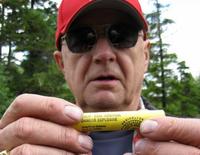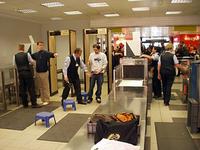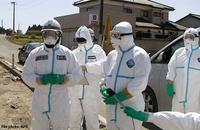-
Infrared sensors could help police detect suicide vests
Sophisticated infrared sensors originally designed for the U.S. military could soon be used by local police departments to detect suicide bombers; Thermal Matrix USA initially designed its Access Counter IED Technology system to assist military personnel in Iraq and Afghanistan identify potential suicide bombers, but hopes to create a model that local law enforcement agencies can deploy; the company has modified its product to significantly reduce its size, weight, and deployment time to be more practical; the devices are capable of detecting any hidden objects including knives, guns, plastics, and even liquids
-
-
U.K. lab helps company improve its infrastructure monitoring sensors
London-based Senceive produces sensors used in long-term infrastructure monitoring; the company’s meshed systems of wireless sensors are used to assess the condition of railway structures, track, bridges, culturally significant buildings, and even historical artifacts; the company needed the help of the U.K. National Physical Laboratory to improve the tilt sensing system it manufactures, and verify its accuracy, precision, and limits
-
-
Remote bomb detection sensors
European scientists are embarking on a project to develop a network of state-of-the-art sensors capable of detecting hidden explosives; the sensors will work by detecting the chemical traces of explosive vapors in the air in order to provide early warning to security services and protect vulnerable urban populations from the threat of Improvised Explosive Devices (IEDs), often used by terrorist organizations
-
-
Researchers use bee venom to detect explosives
Using bee venom, researchers have developed new bomb detectors that are so sensitive they are capable of detecting a single molecule of an explosive; when chemical engineers at the Massachusetts Institute of Technology (MIT) coated carbon nanotubes in bombolitins, protein fragments found in bee venom, they discovered that these proteins reacted with nitro-aromatic compounds like TNT at the molecular level; current bomb detectors rely on spectrometry which analyzes charged particles as they move through the air, which makes them far less sensitive than the recently developed bee-based detectors
-
-
New 2-in-1 explosive detector and neutralizer
A two-in-one material that can both detect and neutralize explosives of the type favored by terrorists is unveiled; the material is made of metal oxide nanoparticles so small that 50,000 could fit across the width of a single human hair; it changes color in the presence of certain explosives, alerting emergency responders to the threat; it also can be sprayed onto bombs or suspicious packages to inactivate certain explosives
-
-
New sensor detects minute traces of explosives
MIT chemical engineers develop a new sensor that can detect minute traces of explosives; the new sensors would be more sensitive than existing explosives detectors — those commonly used at airports, for example — which use spectrometry to analyze charged particles as they move through the air
-
-
ATF cracks down on bombs used to scare seals

Much to the frustration of California fishermen, the U.S. Bureau of Alcohol, Tobacco, Firearms, and Explosives (ATF) is starting to regulate the firecrackers used to scare away seals from fishing lines; beginning 1 May, ATF officials will begin enforcing a federal law that mandates anyone who purchases the seal “bombs” to obtain a special permit and clear a background check in order to prevent terrorists or criminals from using them; the bombs resemble M-80 firecrackers and are shot from a gun; fishermen and farmers use them to scare away animals like hungry birds or seals
-
-
New technology quickly detects bioattacks on water supply systems
If pathogens enter into a city water supply network, many people may fall ill quickly; to protect against this biological threat, researchers have developed a detection system, partly based on nanotechnology, that can warn authorities in time
-
-
Brain, not eyes, performs near-optimal visual search
In the wild, mammals survive because they can see and evade predators lurking in the shadowy bushes; this ability translates to the human world — Transportation Security Administration (TSA) screeners can pick out dangerous objects in an image of our messy and stuffed suitcases
-
-
Sector Report for Monday, 9 May 2011: Detection
This report contains the following stories.
-
-
Researchers use gamma rays to detect hidden nuclear threats
Researchers are currently exploring methods to use gamma rays to develop more powerful nuclear detection devices that can penetrate lead or other thick containers; scientists have created “MEGa-rays” by using fast-moving electrons to convert laser photons into the gamma part of the spectrum; these MEGa-rays are then tuned to a specific energy frequency so that they will only react with a certain type of material like uranium-235 which is used in nuclear fuel; scientists expect that the technology will be developed within the next several years
-
-
Smiths Detection launches new radiation detector; president steps down
Last week Smiths Detection unveiled its new hand-held radiation detection device that is capable of more accurately identifying radiological and nuclear threats; the “RadSeeker” is designed to have a wide-range of applications to enable security officials and first responders to detect nuclear threats in addition to scanning cargo for nuclear material; the president of Smiths Group, Smiths Detection’s parent company, announced that he would step down; his decision is a result of weak sales at Smiths Detection
-
-
Dayton installs automated baggage screening system at airport

On 17 May Dayton International Airport in Ohio will begin using a sophisticated new automated baggage screening system that will save time and resources; using a series of machines, the new system will automatically screen luggage for explosives; any suspicious bags will be flagged and sent to security screeners for more careful examination; TSA officials hope that the new machines will help reduce check-in times for passengers, increase efficiency, and even minimize the number of screeners needed
-
-
Japan attempts "cold shutdown" at reactor no. 1

Officials at the Tokyo Electric Power Company (TEPCO) hope to bring reactor no. 1 at the beleaguered Fukushima Daiichi nuclear plant to a “cold shutdown” by the end of the week; plant operators will attempt to bring the temperature inside the reactor below the boiling point of water so that it will no longer produce radioactive steam; the building housing reactor no. 1 must be vented so that all the radioactive air that has accumulated is released allowing workers to approach the reactor; once inside workers will inject cold water into the reactor’s primary containment structure; injecting tons of water into a damaged containment unit that houses uranium makes some scientists uneasy
-
-
Recipe for radioactive materials helps in studies of nuclear waste and fuel storage pools
Easy-to-follow recipes for radioactive compounds like those found in nuclear fuel storage pools, liquid waste containment areas, and other contaminated aqueous environments have been developed by researchers at Sandia National Laboratories; the trick to the recipes is choosing the right templates; these are atoms or molecules that direct the growth of compounds in much the way islands act as templates for coral reefs
-
More headlines
The long view
Keeping the Lights on with Nuclear Waste: Radiochemistry Transforms Nuclear Waste into Strategic Materials
How UNLV radiochemistry is pioneering the future of energy in the Southwest by salvaging strategic materials from nuclear dumps –and making it safe.
Model Predicts Long-Term Effects of Nuclear Waste on Underground Disposal Systems
The simulations matched results from an underground lab experiment in Switzerland, suggesting modeling could be used to validate the safety of nuclear disposal sites.
